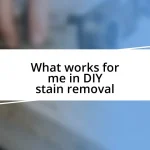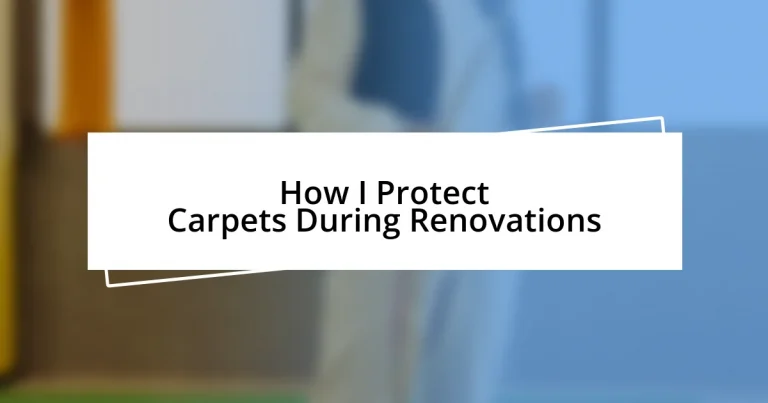Key takeaways:
- Careful planning and selecting the right protection materials, such as carpet protector film and reusable mats, are essential for safeguarding carpets during renovations.
- Thorough preparation, including decluttering and securing protective measures, can significantly prevent damage to carpets throughout the renovation process.
- Post-renovation care, including deep cleaning and regular maintenance, is crucial to restore carpets and ensure their long-term quality and appearance.

Understanding Carpet Protection Needs
When renovating your space, it’s crucial to assess how your carpets will bear the brunt of the chaos. I remember a time when I underestimated the mess and thought a few drop cloths would suffice. The aftermath was a grim reminder that protecting carpets requires more than just a band-aid solution; it demands careful planning.
Consider the nature of your project, too. Will there be heavy furniture moving in and out, or perhaps some dusty demolition? I once saw a friend’s beautiful plush carpet get imprinted with scuff marks from a tool-laden dolly simply because they didn’t think deeply about the load they were bringing in. It made me realize that understanding my specific protection needs hinges on foreseeing potential risks.
There’s also the matter of what materials you choose to safeguard your carpets. I once experimented with various protective films and mats, discovering that some worked brilliantly while others left sticky residues. Asking yourself, “What’s worth the risk?” will guide you in selecting the best options, ultimately preserving the beauty of your carpets throughout the renovation.

Choosing the Right Protection Materials
When it comes to choosing the right protection materials, I’ve learned that not all options are created equal. During one of my renovations, I opted for a heavy-duty plastic sheeting. Initially, I thought it would do the job, but to my dismay, it slipped around and didn’t hold up against the foot traffic. Instead, I found that using a carpet protector film, which clings to the fibers without causing damage, provided a much more stable barrier against spills and dirt.
Here are some materials worth considering:
- Carpet Protector Film: A clear, sticky film that adheres to carpets, offering strong protection without leaving a residue.
- Reusable Carpet Mats: These can withstand heavy foot traffic and are easy to clean and reposition.
- Cardboard Sheets: Cost-effective and sturdy for high traffic areas, though they can be bulkier to handle.
- Drop Cloths: Ideal for protecting furniture or corners but should be heavy-duty to prevent sliding around.
- Rug Gripper Pads: Providing additional traction, they can help keep protection materials in place, especially on slippery surfaces.
Choosing wisely from these options is essential. I can’t stress enough how much hassle a poor choice can cause. Trust me, you don’t want to deal with the aftermath of damages caused by inadequate protection.

Preparing Carpets Before Renovations
Preparing carpets before renovations is a critical step I’ve learned to prioritize, especially after having faced the consequences of neglecting it in the past. Once, during a particularly enthusiastic home makeover, I left a section of carpet exposed, thinking it would be fine. I came back to find stains and fraying edges that broke my heart. It made me realize just how vulnerable carpets can be when not properly protected; anticipation of the chaos ahead can save a lot of future sorrow.
Another essential aspect is removing any smaller items and furniture that could become hazards. I once decided to leave some decor in place because I thought it would be easier. That decision led to a chair leg leaving a mark on my carpet, and believe me, that didn’t just ruin my day—it added hours of labor trying to fix it. Therefore, I can confidently say that a thorough decluttering can significantly mitigate risks. Consider it as an investment in your carpet’s longevity.
Finally, securing your barriers in place is just as important as choosing the right protection materials. I learned this when I wrapped my carpets with tape, thinking it would keep everything in check. Instead, the tape tore the fibers when it was removed later. Using painter’s tape instead is a much gentler option. So always double-check that your protective measures are not just laid on top but firmly in place to shield your carpets effectively.
| Material | Description |
|---|---|
| Carpet Protector Film | Adheres gently to carpet fibers, providing strong spill and dirt protection without sticky residue. |
| Reusable Carpet Mats | Durable and easy to clean mats, perfect for high-foot-traffic areas. |
| Cardboard Sheets | A cost-effective solution for heavy items, although they require careful handling due to their bulk. |
| Drop Cloths | Effective for covering furniture but ensure they’re heavy-duty to resist sliding. |
| Rug Gripper Pads | Add stability to ensure protection materials remain in place on slippery floors. |

Effective Covering Techniques
When it comes to effective covering techniques, I often lean toward using carpet protector film, which has been a game-changer for me. I remember one specific project where I laid the film down, confident that it would safeguard my carpet from inevitable spills during renovations. The satisfaction of seeing my carpet unscathed at the end of the day was worth every minute spent applying that film.
Another reliable method I’ve discovered is utilizing reusable carpet mats. I typically position these in high-traffic areas where my family or workers will frequently walk. Once, during a kitchen remodel, I found myself constantly cleaning up messes, but those mats absorbed the majority of the dirt—what a relief! After that experience, I always make sure to have these mats ready; they not only protect but also contribute to a tidier work environment.
I also recommend layering protection with cardboard sheets for areas where heavier items will be moved. There was an occasion when I underestimated the weight of a bulky dresser being moved, and without the cardboard in place, I cringed seeing the scuff marks left behind. It’s a simple step, but ask yourself: why risk damaging your carpet when a little extra planning can prevent heartache later? I’ve learned that being proactive about protecting carpets during renovations not only saves time but also spares you from a world of frustration.

Maintaining Carpet Quality During Work
Maintaining the quality of carpets during renovations really hinges on vigilance and proactive strategies. I’ve often found that regular checks on protective coverings can make all the difference. In one particular instance, while renovating a home office, I noticed a corner of the carpet protector film had come loose. Just that small oversight led to a spill that seeped through, leaving me with a stain that became a constant reminder of my negligence.
Another delightful discovery I made was the value of using thick drop cloths over my carpets. I always thought they were just for painting, but during a reno involving tile installation, I placed them strategically to catch any debris. To my pleasant surprise, not only did they protect the carpet beneath, but they also provided an easy cleanup afterward. Isn’t it amazing how the simplest solutions can save us time and heartache?
Lastly, I highly recommend creating a clear pathway for workers, which helps keep vital areas free from accidental damage. One time, after I had gone through all the protective measures, a worker inadvertently dropped a tool that landed hard on my carpet. Having established a good traffic flow could have prevented that mishap entirely. So, ask yourself—how can you make navigating your space easier while ensuring your carpets stay unscathed during the chaos of renovations?

Post-Renovation Cleaning and Care
After the dust settles on renovations, the real work begins—cleaning and caring for your carpets. I remember one project where I thought I could just vacuum and call it a day, only to discover a fine layer of dust woven deep into the fibers. A thorough deep clean with a carpet cleaner made such a difference; the freshness was like welcoming back an old friend. It’s fascinating how little things can transform the appearance and smell of your home.
I’ve also learned that regular maintenance, such as spot cleaning any stains right away, shouldn’t be underestimated. During a recent bathroom update, a mishap with paint nearly had me in tears. Thankfully, I had a few handy cleaning supplies on hand. With some quick action and a dash of elbow grease, I managed to lift the stain before it set in—thank goodness! Have you ever faced a similar panic moment? It’s incredible how a proactive approach can alleviate potential disasters.
On top of that, frequent vacuuming post-renovation isn’t just for aesthetics; it’s essential for the health of your carpet. I try to vacuum more than usual after any project, and it’s always satisfying to see how much debris ends up in the bin. It’s a little effort that keeps carpet fibers from wearing out prematurely and maintains that plush, welcoming feel I love. So, why not make it a habit? Your carpets will thank you for it!

Tips for Long-Term Carpet Protection
To ensure your carpets remain pristine during long-term renovations, I’ve found that using high-quality adhesive carpet protectors can be a game-changer. I vividly recall a time when I used a premium version, and it adhered perfectly without peeling, even through the mess of installing cabinets. It was so reassuring to know that my carpets were shielded from spills and debris, allowing me to focus on the bigger picture of the renovation without constant worry.
Another tip I swear by is to keep a designated “work zone” completely separated from carpeted areas. I made this mistake a few years back when I renovated my kitchen, and tools ended up all over the living room carpet. The mess was overwhelming, and I wished I had thought to use temporary barriers. By designating spaces for tools and supplies, I can avoid those frantic moments of panic when I think about how to clean a carpet spattered with paint or dust.
Finally, I encourage everyone to invest in a good-quality weather-resistant mat at entrances. During one major home improvement project, I installed one that effectively caught dirt and moisture, lessening the grime tracking onto my carpets. It made such a difference, both visually and in terms of cleanliness. Have you ever considered how many messes get brought in from outside? By placing this simple mat, I felt more at ease knowing that my carpets were less exposed to the outside chaos.














